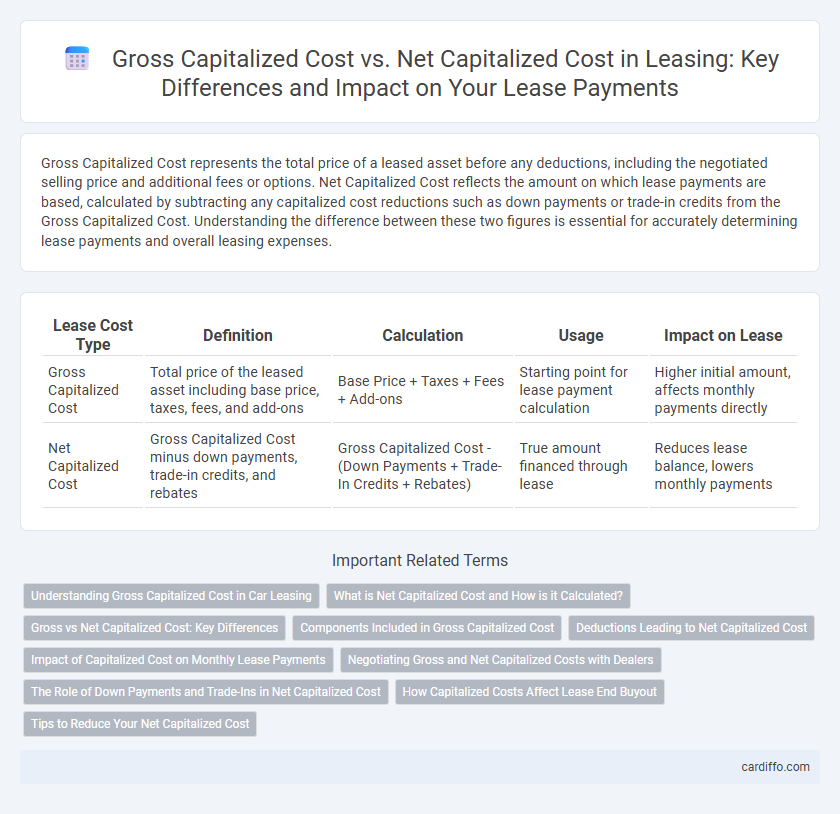Gross Capitalized Cost represents the total price of a leased asset before any deductions, including the negotiated selling price and additional fees or options. Net Capitalized Cost reflects the amount on which lease payments are based, calculated by subtracting any capitalized cost reductions such as down payments or trade-in credits from the Gross Capitalized Cost. Understanding the difference between these two figures is essential for accurately determining lease payments and overall leasing expenses.
Table of Comparison
| Lease Cost Type | Definition | Calculation | Usage | Impact on Lease |
|---|---|---|---|---|
| Gross Capitalized Cost | Total price of the leased asset including base price, taxes, fees, and add-ons | Base Price + Taxes + Fees + Add-ons | Starting point for lease payment calculation | Higher initial amount, affects monthly payments directly |
| Net Capitalized Cost | Gross Capitalized Cost minus down payments, trade-in credits, and rebates | Gross Capitalized Cost - (Down Payments + Trade-In Credits + Rebates) | True amount financed through lease | Reduces lease balance, lowers monthly payments |
Understanding Gross Capitalized Cost in Car Leasing
Gross Capitalized Cost in car leasing represents the total price of the vehicle before any trade-in allowances, incentives, or down payments are applied, encompassing the negotiated selling price plus any additional fees or taxes. This figure is crucial for calculating monthly lease payments, as it establishes the baseline amount subject to depreciation over the lease term. Understanding the Gross Capitalized Cost enables lessees to negotiate better terms by focusing on reducing this initial capitalized amount before rebates and credits are subtracted to determine the Net Capitalized Cost.
What is Net Capitalized Cost and How is it Calculated?
Net Capitalized Cost, also known as the adjusted capitalized cost, represents the amount on which lease payments are based after accounting for down payments, trade-in credits, and incentives. It is calculated by subtracting these reductions from the Gross Capitalized Cost, which is the total negotiated price of the vehicle plus any additional fees or taxes included in the lease agreement. This adjusted figure directly impacts the monthly lease payments and overall lease affordability.
Gross vs Net Capitalized Cost: Key Differences
Gross Capitalized Cost represents the total price of a leased asset before deductions, including the negotiated selling price plus any additional fees or taxes. Net Capitalized Cost is the amount left after subtracting the initial down payments, trade-in credits, or incentives from the gross capitalized cost, reflecting the true amount financed through the lease. Understanding the distinction is crucial for accurately calculating monthly lease payments and assessing lease affordability.
Components Included in Gross Capitalized Cost
Gross Capitalized Cost in a lease includes the negotiated price of the vehicle, taxes, registration fees, and any additional options or packages added to the base model. It also incorporates acquisition fees, extended warranties, and any manufacturer rebates or incentives applied at signing. This comprehensive calculation forms the basis for determining monthly lease payments before deductions like trade-in value or down payment adjust the figure to the Net Capitalized Cost.
Deductions Leading to Net Capitalized Cost
Gross Capitalized Cost represents the total price of the leased asset before any deductions, including the agreed-upon selling price, taxes, and fees. Net Capitalized Cost is derived by subtracting capitalized cost reductions such as trade-in allowances, rebates, and down payments from the Gross Capitalized Cost. These deductions lower the amount financed in the lease, directly impacting monthly lease payments and overall lease expense.
Impact of Capitalized Cost on Monthly Lease Payments
Gross Capitalized Cost represents the total initial value of the leased asset before any reductions, directly influencing higher base monthly lease payments due to the larger amount being financed. Net Capitalized Cost subtracts incentives, trade-ins, and down payments from the gross amount, lowering the principal used to calculate monthly payments and thereby reducing the lessee's financial obligation. Understanding the distinction and adjustments to the capitalized cost is crucial for accurately projecting affordable and manageable monthly lease payments.
Negotiating Gross and Net Capitalized Costs with Dealers
Negotiating Gross Capitalized Cost involves reducing the vehicle's initial price before lease calculations, impacting overall monthly payments and lease terms. Focus on discounts, rebates, and dealer incentives to lower the gross capitalized cost effectively. Understanding the difference between gross and net capitalized cost ensures clarity on fees and adjustments dealers may apply, helping lessees negotiate better lease deals.
The Role of Down Payments and Trade-Ins in Net Capitalized Cost
Net Capitalized Cost in leasing reflects the Gross Capitalized Cost minus any down payments and trade-in credits, significantly reducing the initial amount financed. Down payments directly lower the Net Cap Cost, decreasing monthly lease payments and overall lease expense. Trade-ins provide additional credit that further reduces Net Capitalized Cost, enhancing affordability and lease terms.
How Capitalized Costs Affect Lease End Buyout
Gross Capitalized Cost refers to the total negotiated price of a leased asset before any incentives or rebates, directly impacting the initial amount subject to depreciation during the lease term. Net Capitalized Cost subtracts these incentives or down payments from the Gross Capitalized Cost, reducing the overall lease expense and influencing the residual value and final buyout price at lease end. Higher Capitalized Costs increase the buyout price since the asset's depreciated value bases on these costs, affecting lessee's decision to purchase or return the asset.
Tips to Reduce Your Net Capitalized Cost
Negotiating a lower purchase price and securing manufacturer incentives or rebates effectively reduce your gross capitalized cost, directly impacting your net capitalized cost in a lease agreement. Minimizing additional fees such as acquisition or documentation fees and opting for a higher down payment can further decrease the net capitalized cost. Regularly reviewing and comparing lease offers, along with leveraging loyalty programs, helps optimize your lease terms for cost savings.
Gross Capitalized Cost vs Net Capitalized Cost Infographic

 cardiffo.com
cardiffo.com